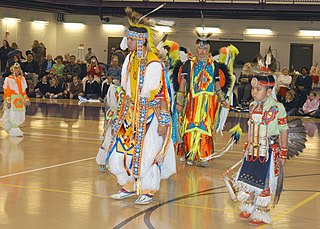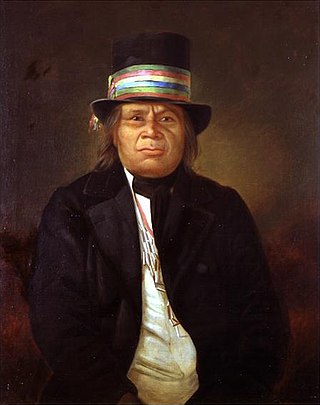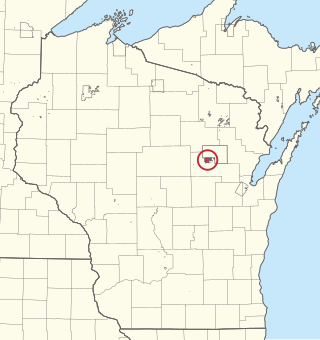Related Research Articles

Shawano County is a county located in the U.S. state of Wisconsin. As of the 2020 census, the population was 40,881. Its county seat is Shawano.

The American Indian Movement (AIM) is a Native American grassroots movement which was founded in Minneapolis, Minnesota in July 1968, initially centered in urban areas in order to address systemic issues of poverty, discrimination, and police brutality against Native Americans. AIM soon widened its focus from urban issues to many Indigenous Tribal issues that Native American groups have faced due to settler colonialism in the Americas. These issues have included treaty rights, high rates of unemployment, Native American education, cultural continuity, and the preservation of Indigenous cultures.
Menominee, also spelled Menomini is an endangered Algonquian language spoken by the historic Menominee people of what is now northern Wisconsin in the United States. The federally recognized tribe has been working to encourage revival of use of the language by intensive classes locally and partnerships with universities. Most of the fluent speakers are elderly. Many of the people use English as their first language.

The Ho-Chunk, also known as Hocąk, Hoocągra, or Winnebago, are a Siouan-speaking Native American people whose historic territory includes parts of Wisconsin, Minnesota, Iowa, and Illinois. Today, Ho-Chunk people are enrolled in two federally recognized tribes, the Ho-Chunk Nation of Wisconsin and the Winnebago Tribe of Nebraska.
James Edmund Groppi was an erstwhile Catholic priest and noted civil rights activist based in Milwaukee, Wisconsin. He became well known for leading numerous protests, many times being arrested during them. In 1976, he was excommunicated by the church for marrying. In 1985, he died of brain cancer at the age of 54.

The Menominee are a federally recognized nation of Native Americans. Their land base is the Menominee Indian Reservation in Wisconsin. Their historic territory originally included an estimated 10 million acres (40,000 km2) in present-day Wisconsin and the Upper Peninsula of Michigan. The tribe currently has about 8,700 members.

Annie Mae Aquash was a First Nations activist and Mi'kmaq tribal member from Nova Scotia, Canada. Aquash moved to Boston in the 1960s and joined other First Nations and Indigenous Americans focused on education and resistance, and police brutality against urban Indigenous peoples. She was part of the American Indian Movement, participated in several occupations, and participated in the 1973 Wounded Knee incident at the Pine Ridge Indian Reservation, United States.

The Alexians officially named as the Congregation of Alexian Brothers abbreviated C.F.A., is a Catholic lay religious congregation of Pontifical Right for men specifically devoted to caring for the sick which has its origin in Europe at the time of the Black Death. They follow the Augustinian rule.


The Red Power movement was a social movement led by Native American youth to demand self-determination for Native Americans in the United States. Organizations that were part of the Red Power Movement include the American Indian Movement (AIM) and the National Indian Youth Council (NIYC). This movement sought the rights for Native Americans to make policies and programs for themselves while maintaining and controlling their own land and resources. The Red Power movement took a confrontational and civil disobedience approach to inciting change in United States to Native American affairs compared to using negotiations and settlements, which national Native American groups such as National Congress of American Indians had before. Red Power centered around mass action, militant action, and unified action.
Indian termination is a phrase describing United States policies relating to Native Americans from the mid-1940s to the mid-1960s. It was shaped by a series of laws and practices with the intent of assimilating Native Americans into mainstream American society. Cultural assimilation of Native Americans was not new; the belief that indigenous people should abandon their traditional lives and become what the government considers "civilized" had been the basis of policy for centuries. What was new, however, was the sense of urgency that, with or without consent, tribes must be terminated and begin to live "as Americans." To that end, Congress set about ending the special relationship between tribes and the federal government.
The Bureau of Indian Affairs building takeover refers to a protest by Native Americans at the Department of the Interior headquarters in the United States capital of Washington, D.C., from November 3 to November 9, 1972. On November 3, a group of around 500 American Indians with the American Indian Movement (AIM) took over the Interior building in Washington, D.C. It being the culmination of their cross-country journey in the Trail of Broken Treaties, intended to bring attention to American Indian issues such as living standards and treaty rights.

Chief Oshkosh was a chief of the Menominee Native Americans, recognized as the leader of the Menominee people by the United States government from August 7, 1827, until his death. He was involved in treaty negotiations as the United States sought to acquire more of the Menominee tribe's land in Wisconsin and Michigan for both white settlers and relocated Oneida, Stockbridge, Munsee, and Brothertown Indians. During his tenure as head chief, the Menominee ceded over 10,000,000 acres of land to the United States. However, Oshkosh resisted U.S. government pressure for the tribe to relocate to northern Minnesota and played a key role in securing the 235,524-acre (953.13 km2) Menominee Indian Reservation as a permanent home for his people on their ancestral land.
Menominee Tribe v. United States, 391 U.S. 404 (1968), is a case in which the Supreme Court ruled that the Menominee Indian Tribe kept their historical hunting and fishing rights even after the federal government ceased to recognize the tribe. It was a landmark decision in Native American case law.
Bryan v. Itasca County, 426 U.S. 373 (1976), was a case in which the Supreme Court of the United States held that a state did not have the right to assess a tax on the property of a Native American (Indian) living on tribal land absent a specific Congressional grant of authority to do so.

This is a list of the National Register of Historic Places listings in Langlade County, Wisconsin. It is intended to provide a comprehensive listing of entries in the National Register of Historic Places that are located in Langlade County, Wisconsin. The locations of National Register properties for which the latitude and longitude coordinates are included below may be seen in a map.

This is a list of the National Register of Historic Places listings in Shawano County, Wisconsin. It is intended to provide a comprehensive listing of entries in the National Register of Historic Places that are located in Shawano County, Wisconsin. The locations of National Register properties for which the latitude and longitude coordinates are included below may be seen in a map.
Brother Stephen Russell was a poet, comedian, Alexian Brother, Good Samaritan and carer of down and outs. Brother Russell House in Limerick is named after him in honour of his work with helping Limerick's homeless in the 1970s.
This Day in North American Indian History is a reference work on the history of the indigenous peoples of North America, organized by calendar date. The author is Phil Konstantin, a member of the Cherokee Nation. The book was published in 2002 by Da Capo Press.
There were ten American Indian Boarding Schools in Wisconsin that operated in the 19th and 20th centuries. The goal of the schools was to culturally assimilate Native Americans to European–American culture. This was often accomplished by force and abuse. The boarding schools were run by church, government, and private organizations.
References
- ↑ "Alexian Brothers' Novitiate". Geographic Names Information System . United States Geological Survey, United States Department of the Interior.
- ↑ "Alexian Brothers // Alexian Brothers Novitiate: Gresham, WI". Alexian Brothers. Archived from the original on 6 May 2013. Retrieved 11 February 2013.
- ↑ Pulaski, Lee (6 January 2012). "Remembering the Novitiate". Shawano Leader. Archived from the original on 24 January 2012. Retrieved 11 February 2013.
- ↑ The Cracker Baker. American Trade Publishing Company. 1922.
- ↑ "Alexian Brothers // Alexian Brothers Novitiate: Gresham, WI". Alexian Brothers. Archived from the original on 6 May 2013. Retrieved 11 February 2013.
- ↑ Tempus, Alexandra (24 November 2008). "No Trespassing" (PDF). williamcronon.net. Retrieved 8 December 2019.
- ↑ "Alexian Brothers // Alexian Brothers Novitiate: Gresham, WI". Alexian Brothers. Archived from the original on 6 May 2013. Retrieved 11 February 2013.
- 1 2 3 Tronnes, Libby R. (2002). ""Where Is John Wayne?": The Menominee Warriors Society, Indian Militancy, and Social Unrest during the Alexian Brothers Novitiate Takeover". American Indian Quarterly. 26 (4): 526–558. doi:10.1353/aiq.2004.0012. ISSN 0095-182X. JSTOR 4128502. S2CID 161748883.
- ↑ Tronnes, Libby R. (2002). ""Where Is John Wayne?": The Menominee Warriors Society, Indian Militancy, and Social Unrest during the Alexian Brothers Novitiate Takeover". American Indian Quarterly. 26 (4): 526–558. doi:10.1353/aiq.2004.0012. ISSN 0095-182X. JSTOR 4128502. S2CID 161748883.
- ↑ Siebert, Tim. "Alexian Brothers' Novitiate Stand Off". Portage County Historical Society. Archived from the original on 12 October 2011. Retrieved 12 February 2013.
- ↑ Pulaski, Lee (6 January 2012). "Remembering the Novitiate". Shawano Leader. Archived from the original on 24 January 2012. Retrieved 11 February 2013.
- ↑ "The Abbey & Me". Vimeo. Retrieved 2019-12-09.
- ↑ Siebert, Tim. "Alexian Brothers' Novitiate Stand Off". Portage County Historical Society. Archived from the original on 12 October 2011. Retrieved 12 February 2013.
- ↑ "Alexian Brothers // Alexian Brothers Novitiate: Gresham, WI". Alexian Brothers. Archived from the original on 6 May 2013. Retrieved 11 February 2013.
- ↑ "Alexian Brothers // Alexian Brothers Novitiate: Gresham, WI". Alexian Brothers. Archived from the original on 6 May 2013. Retrieved 11 February 2013.
- ↑ "Remembering the Novitiate - Shawano Leader - Shawano, WI". 2012-01-24. Archived from the original on 2012-01-24. Retrieved 2019-12-08.
- ↑ "Red: C) Lower Red Lake Dam to CTH.A (4.3 miles)". www.americanwhitewater.org. Retrieved 2019-12-09.
- ↑ "Alexian Brothers // Alexian Brothers Novitiate: Gresham, WI". Alexian Brothers. Archived from the original on 6 May 2013. Retrieved 11 February 2013.
- ↑ "The Abbey & Me a.k.a The Novitiate". J. Patrick Rick. Retrieved 23 February 2013.
- ↑ The Abbey & Me: Renegades, Rednecks, Real Estate & Religion. 2011. ISBN 978-1456491819.
{{cite book}}:|work=ignored (help)